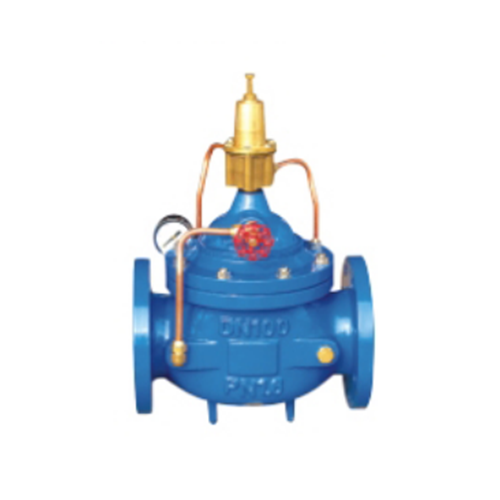Holding pressure valve is mainiy used for fire or other water supply systems relief,in order to prevent overpressure or maintenance of fire water supply system pressure.Fire pump can also features closed,so that a larger proportion of larger diameter,suspended partides will not enter the oontrol system,to ensure that the system of airaulating SMOOTH OPERATOR,safe and reliable operation of the valve.The system movement is stable,high strength,long service life.The following applies to DN600 diameter pipe.
The main dimensions
DN | 20 | 25 | 32 | 40 | 50 | 65 | 80 | 100 | 125 | 150 | 200 | 250 | 300 | 350 | 400 | 450 |
L | 150 | 160 | 180 | 200 | 203 | 216 | 241 | 292 | 330 | 356 | 495 | 622 | 698 | 787 | 914 | 978 |
H1 | 463 | 463 | 463 | 516 | 516 | 520 | 537 | 596 | 653 | 709 | 805 | 855 | 953 | 990 | 1030 | 1030 |
H | 557 | 557 | 557 | 610 | 610 | 625 | 642 | 750 | 808 | 884 | 1135 | 1185 | 1325 | 1385 | 1445 | 1445 |
Pressure Relief/Holding Pressure Valve: Complete Guide for Industrial Applications
The Pressure Relief/Holding Pressure Valve is a vital component in hydraulic and pneumatic systems. It serves two key functions: relieving excess pressure to protect equipment and maintaining holding pressure to ensure precise system performance. These valves are widely used in industrial machinery, injection molding systems, fluid power systems, and automated production lines. Understanding valve specifications, operation, maintenance, and proper handling is essential for maximizing system efficiency and ensuring safety.
A pressure relief/holding pressure valve performs dual functions:
Pressure Relief: Releases excess system pressure to prevent damage to pipelines, cylinders, or machinery components.
Holding Pressure: Maintains consistent pressure in hydraulic or pneumatic systems during pauses or controlled operations, ensuring smooth and accurate process control.
Protects system components from overpressure damage
Ensures precise control of pressure during operation
Reduces wear and tear on machinery
Enhances system efficiency and reliability
Pressure relief/holding pressure valves are available in multiple models to suit different system requirements. Typical specifications include:
| Specification | Description |
|---|---|
| Pressure Range | 0–350 bar (varies by model) |
| Flow Rate | 1–120 L/min (depending on valve size) |
| Material | Stainless steel, brass, or high-strength alloys |
| Connection Type | Threaded, flanged, or manifold-mounted |
| Operating Temperature | -20°C to 120°C (standard), extended ranges available |
| Adjustment Method | Manual, mechanical, or electronically controlled |
These valves can be customized to meet specific industrial requirements, such as high-temperature resistance, chemical compatibility, or precise flow control.

Proper operation is crucial for achieving optimal performance and longevity. The general operation process includes:
System Preparation: Ensure the system is depressurized and free from contaminants before installation.
Installation Orientation: Follow manufacturer guidelines for correct flow direction and mounting orientation.
Initial Adjustment: Set the desired holding pressure and maximum relief pressure according to system requirements.
Start-Up Procedure: Gradually pressurize the system and monitor the valve response to ensure smooth pressure regulation.
Monitoring: Regularly check pressure gauges and system feedback to verify that the valve maintains proper relief and holding pressures.
Regular maintenance is essential for reliable operation and extended valve life. Recommended maintenance cycles are:
| Maintenance Interval | Recommended Action |
|---|---|
| Daily | Check for visible leaks and unusual noises |
| Weekly | Inspect pressure settings and verify correct operation |
| Monthly | Clean external surfaces and check mounting integrity |
| Quarterly | Inspect internal components, seals, and springs |
| Annually | Complete valve disassembly, replace worn parts, recalibrate |
Following a structured maintenance schedule reduces the risk of unexpected failures and ensures continuous system performance.
| Issue | Possible Cause | Solution |
|---|---|---|
| Valve leakage | Damaged seals or worn components | Replace seals or internal parts |
| Inconsistent holding pressure | Incorrect adjustment or debris | Recalibrate and clean valve |
| Excessive noise or vibration | Cavitation or high flow turbulence | Adjust system flow, install dampers |
| Slow pressure release | Blocked or restricted relief passage | Clean or replace internal valve components |
Documenting troubleshooting actions helps prevent recurring problems and improves overall maintenance efficiency.
Always depressurize the system before disassembling the valve.
Use manufacturer-recommended lubricants for moving components.
Store spare parts in a clean, dry environment to prevent corrosion.
Keep a maintenance log to track repairs, replacements, and adjustments.
Train operators on correct adjustment procedures to prevent accidental overpressure or damage.
Proper handling during transport and storage ensures the valve reaches its destination in optimal condition:
Packaging: Use protective materials to prevent impact, dust, and moisture exposure.
Temperature Control: Avoid extreme temperatures to maintain seal integrity.
Handling: Avoid dropping or applying excessive force; use lifting equipment for heavy valves.
Inspection: Verify valve functionality and integrity before shipment.
Pressure relief/holding pressure valves are widely used across industries:
Hydraulic Systems: Protect cylinders, pumps, and pipelines from overpressure.
Injection Molding Machines: Maintain precise holding pressure during injection cycles.
Automation Equipment: Ensure consistent pressure for accurate and repeatable processes.
Water Treatment and Chemical Plants: Control fluid flow and protect sensitive equipment.
These applications demonstrate the valve’s versatility and importance in maintaining safe and efficient operations.
A Pressure Relief/Holding Pressure Valve is an essential component for protecting equipment, maintaining system efficiency, and ensuring operational safety. Understanding valve specifications, following proper operation procedures, adhering to maintenance cycles, and implementing quality control measures are key to maximizing performance. With proper care, these valves provide reliable, precise, and long-lasting pressure management solutions for a wide range of industrial applications.
This website uses cookies to ensure you get the best experience on our website.